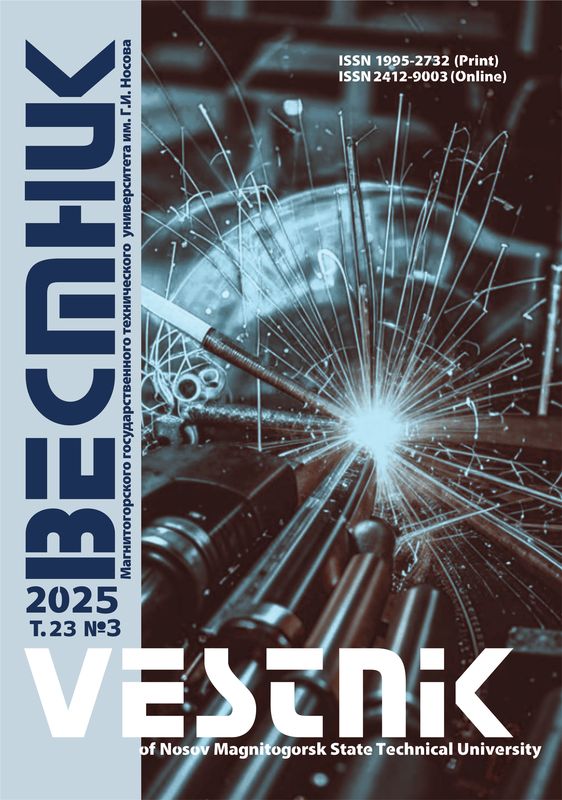DOI: 10.18503/1995-2732-2024-22-4-81-88
Abstract
Problem Statement (Relevance). During developing new technological solutions aimed at improving the quality of metal products, reducing production costs and increasing productivity, researchers face a number of limitations related to the improvement of technological production processes. Thus, when processing a strip of low-carbon steels 08ps, 10, 20, etc., there is a problem of underestimated initial thicknesses of semi-finished hot rolled products, which can be resolved by increasing the technological plasticity of the rolled product during cold deformation. This, for its part, will affect the growth of the productivity of the wide-strip hot rolling mill. Objectives. Defining the rational parameters of the process of asymmetric rolling of a strip of 08ps and 20 steels, ensuring an increase in the technological plasticity of the material during cold rolling is required. Methods Applied. Experimental studies of asymmetric rolling of strips of 08ps and 20 steels were carried out on a large-scale research facility, such as the industrial and laboratory asymmetric rolling mill 400. The rolls speed ratio V1/V2 was set equal to 1,25 and 5. Result. It is shown that with asymmetric rolling of a strip of 08ps steel of 1 mm final thickness at V1/V2 = 1,25, it is possible to increase the thickness of the semi-finished hot rolled products by 1,7 times. When producing a strip of steel 20 of 2 mm final thickness, it is possible to increase the semi-finished hot rolled products thickness by 1,5 times. With an increase in the rolls speed ratio to 5, a simultaneous decrease in the rolling force by 2,58 times and an increase in the relative reduction from 62% to 80% are observed. Practical Relevance. The research results can be used to create new technological schemes for the production of strips from low-carbon steels (08ps, 10, 20) on cold rolling mills that include stands with individual drives for the working rolls.
Keywords
low-carbon steel, semi-finished hot rolled products, asymmetric cold rolling, rolling force, fibrous structure
For citation
Pesin A.M., Pustovoytov D.O., Biryukova O.D., Baryshnikova A.M., Nosov L.V., Baryshnikov P.M. The Effect of Asymmetric Cold Rolling on the Technological Plasticity of Low-Carbon Steels. Vestnik Magnitogorskogo Gosudarstvennogo Tekhnicheskogo Universiteta im. G.I. Nosova [Vestnik of Nosov Magnitogorsk State Technical University]. 2024, vol. 22, no. 4, pp. 81-88. https://doi.org/10.18503/1995-2732-2024-22-4-81-88
1. Pesin A.M., Pustovoytov D.O., Sverchkov A.I., Kornilov G.P. Experimental testing of the technology of asymmetric cold rolling of strip from high-carbon steel grades to exclude intermediate annealing operations. Chernye metally [Ferrous Metals], 2022;(11):28-35. (In Russ.) doi: 10.17580 / chm.2022.11.03. EDN FWNDLG.
2. Pesin A.M., Dyya H. , Kavalek A., Szhinsky P., Pustovoytov D.O., Satonin A.V., Churukanov A.S. Study of the influence of speed asymmetry on the parameters of various sheet rolling processes. Vestnik Magnitogorskogo gosudarstvennogo tekhnicheskogo universiteta im. G.I. Nosova [Vestnik of the Nosov Magnitogorsk State Technical University], 2014;(1(45)):86-91. (In Russ.)
3. Ashkeyev Zh.A., Andreishchenko V.A., Bukanov Zh.U. Study of the process of asymmetric rolling of blanks. Vestnik Permskogo nacionalnogo issledovatelskogo politekhnicheskogo universiteta. Mekhanika [Bulletin of Perm National Research Polytechnic University. Mechanics],2020;(4):27-35. (In Russ.)
4. Sinitsyn V.G. Theoretical substantiation of reducing the energy-power parameters during asymmetric rolling. Izvestiya vuzov. Chernaya metallurgiya [Bulletin of universities. Ferrous metallurgy],1974;(3):69-72. (In Russ.)
5. Razuvaev D.S. Method of rolling metals. Author’s certificate USSR, No. 63448; No. 30746. Applied: 19.03.1940. Published: 30.04.1944.
6. Pesin A.M., Pustovoitov D.O., Biryukova O.D. , Kozhemyakina A.E. Asymmetric rolling of sheets and strips: history and development prospects. Vestnik Yuzhno-Uralskogo gosudarstvennogo universiteta. Seriya: Metallurgiya [Bulletin of the South Ural State University. Series: Metallurgy], 2020;20(3):81-96. (In Russ.)
7. Pesin A.M., Pustovoytov D.O., Kozhemyakina A.E., Fomin M.Yu., Potaptsev D.M. Analysis of known publications on asymmetric rolling published in ScienceDirect over the past 20 years. Aktualnye problem sovremennoj nauki, tekhniki i obrazovaniya: tezisy dokladov 78-j mezhdunarodnoj nauchno-tekhnicheskoj konferencii [Actual problems of modern science, technology and education. Proceedings of the 78th international scientific and technical conference]. Magnitogorsk, 2020, pp. 175. (In Russ.)
8. Saidakhmedov R.Kh., Bakhadirov K.G. Asymmetric rolling – a promising technology for producing sheet metals with an ultrafine-grained structure. Sovremennye innovacii v nauke i tekhnike: sb. nauch. tr. 8-j Vseross. nauch.-tekhn. konf. [Modern innovations in science and technology: proceedings of the 8th All-Russian scientific and technical conference]. The Southwest State University, Kursk, 2018, pp. 206-208. (In Russ.)
9. Kraner J., Smolar T., Volšak D., Cvahte P., Godec M., Paulin I. A review of asymmetric rolling. Materials and technology. 2020:731-743.
10. Experimental reversible duo sheet rolling mill with individual drive of work rolls. Nauchno-tekhnologicheskaya infrastruktura Rossijskoj Federacii [Scientific and technological infrastructure of the Russian Federation]. Available at: https://ckp-rf.ru/catalog/usu/3206908 (Accessed October 25, 2024).
11. Pesin A.M., Pustovoytov D.O. , Baryshnikov M.P., Biryukova O.D., Kozhemyakina A.E., Nosov L.V., Grachev D.V. Capabilities of the 400 asymmetric rolling mill and the KUKA 160 robotic complex. Mekhanicheskoe oborudovanie metallurgicheskih zavodov [Mechanical equipment of metallurgical plants], 2021;(1(16)):9-13. (In Russ.)
12. Koptseva N.V., Efimova Yu.Yu., Pesin A.M., Pustovoitov D.O., Nosov L.V., Baryshnikova A.M. Formation of an ultrafine-grained structure of 08Yu steel during asymmetric rolling with a mismatch in the speeds of the work rolls. Tekhnologii metallurgii, mashinostroeniya i materialoobrabotki [Technologies of metallurgy, mechanical engineering and materials processing], 2022;(21):83-92. (In Russ.)












